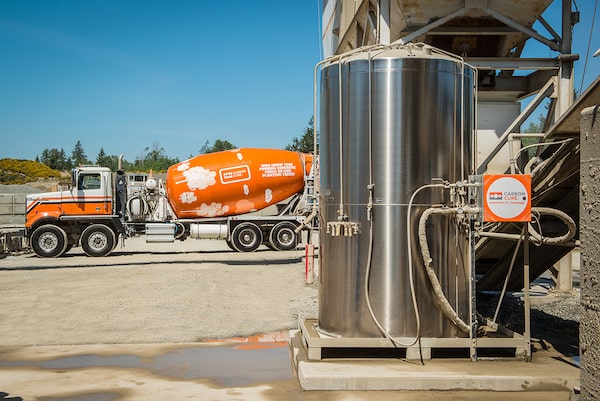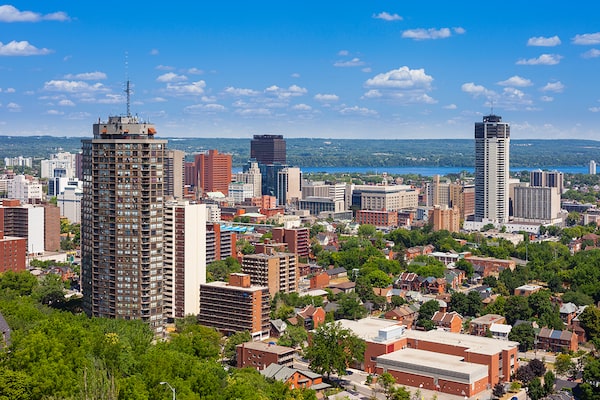
Amazon and the U.S. city of Sacramento are just two of the organizations looking to Halifax-based CarbonCure Technologies, a global leader in reducing and removing carbon dioxide during concrete manufacturing, for help meeting their sustainability goals.CarbonCure
When LinkedIn set out to design its new Middlefield campus in Mountain View, Calif., it wanted the space to be as green as possible. The professional-networking site worked with Halifax-based CarbonCure Technologies to help reach its environmental goals, which include a 75-per-cent reduction in carbon emissions at all of its offices by 2030.
CarbonCure is a global leader in reducing and removing carbon dioxide during concrete manufacturing through its cutting-edge technologies. The company’s systems inject captured CO₂ into fresh concrete during mixing, which triggers a chemical reaction that turns the carbon dioxide into a mineral, removing it from the environment forever.
“This mineralization also enhances the strength of the concrete, which allows the concrete producer to use less cement, which is the carbon-intensive ingredient in concrete,” says Christie Gamble, CarbonCure’s senior director of sustainability. “It’s a win-win scenario.”
This process is vital. Each year, more than four-billion tonnes of cement (the key ingredient in concrete) are produced. Cement gives concrete its strength, but it is carbon intensive. The built environment generates nearly 50 per cent of annual global CO₂ emissions, and just three materials — concrete, steel and aluminum — are responsible for 23 per cent of total global emissions. And development is only growing as more offices and homes are being built: the world will add two trillion square feet of buildings by 2060, according to one estimate.
“Cement and concrete is considered one of those hard-to-abate industries, which means we need a lot of technological innovation to really drive down the carbon contribution that comes from cement manufacturing,” Gamble says.
CarbonCure has sold more than 650 systems to concrete producers around the world and it is helping developments domestically and abroad to reduce their carbon footprints, though they acknowledge there’s much more work to be done.
“CarbonCure’s mission is to reduce 500 million metric tons of carbon emissions annually by the year 2030 within the cement and concrete sector,” Gamble says. “We’ve reduced more than 200,000 metric tons of CO₂ to date, and while we’re very proud of that accomplishment, we have a long way to go to reach our ultimate mission.”
And they’re not the only important player in the movement to make building materials greener. Steelmaker ArcelorMittal Dofasco is also greening the building process in an effort to make global development more sustainable and to ensure big organizations play a role in implementing climate-friendly solutions.
ArcelorMittal Dofasco, located in Hamilton, Ontario, is part of the world’s largest steel and mining company. To reduce the industry’s carbon footprint, the company has committed globally to reducing greenhouse gas emissions 25% by 2030, and carbon neutrality by 2050.

Hamilton-based ArcelorMittal is pivoting to technology that will reduce CO2 emissions by 60 per cent, and creating dozens of jobs in the process.iStockPhoto / Getty Images
ArcelorMittal Dofasco is focusing its efforts on the processing of iron-ore, where the bulk of carbon emissions come from in steelmaking. Steelmaking currently accounts for about 7 per cent to 9 per cent of global carbon emissions, which means it’s imperative to find greener solutions in order to combat climate change. At the same time, steel is one of the few materials that can contribute to a fully circular economy because of its high recyclability—at the end of a steel product’s life, 85 to 90 per cent of that material can be recycled to produce new steel.
‘Many of our customer segments, like automotive and construction, are demanding lower carbon steel. At the same time, the public and consumer interest is in lower carbon and eventually net zero carbon steel,’’ says Tammy Oommen, associate program manager of the Decarbonization Investment Project at ArcelorMittal Dofasco.
That’s why ArcelorMittal Dofasco sees an opportunity to pivot to technology that will reduce CO2 emissions by approximately 60 per cent, as well as limiting or eliminating other environmental impacts. This can occur through a conversion from coal-based to natural gas and electric-based steelmaking. All while supporting the same highly demanding and innovative product mix.
The company will utilize the direct reduction of iron in a hydrogen-ready facility, a method that can produce the same range of high-value steel grades as the current more carbon intensive approach. To get to net zero, the company will look to utilize hydrogen, other biofuel technologies and carbon capture technologies. This project has the potential to transform not just Canada’s steelmaking industry, but also to benefit the economy, create jobs and reinforce steel manufacturing in Hamilton for the next generation.
“This is one of the largest projects in our company’s 110-year history [and] the new stream contributes to the sustainability of well-paying skilled positions in advanced manufacturing,” says Oommen.
“A significant number of contractors and subcontractors are required for the engineering and construction phases of the project — the equivalent of approximately 7,500 cumulative job-years from 2021 to 2028. And our project team is growing with 25 members and more than 40 envisioned by the end of the year. The team will eventually grow to about 150. Plus, new positions, training, and development will be provided for employees moving from existing business units to new assets.”
As demand for this type of technology grows, jobs creation follows. CarbonCure has more than 160 employees across the organization, the majority working within Canada. Gamble says concrete producers are generating more of their concrete with CarbonCure, and its technologies are being used to make big developments greener, including at Amazon’s headquarters in Arlington, Va., and public sidewalks in cities like Sacramento.
For both CarbonCure and ArcelorMittal Dofasco, innovating toward sustainability is both a smart business move and an important indicator of their company values.
“To take a leadership position in being a solution to the climate crisis is an extraordinary accomplishment and one that we are immensely proud of,” says ArcelorMittal Dofasco’s Oommen. “This is simply a transformational project and the beginning of a new era in steelmaking.”
Advertising feature produced by Globe Content Studio with Invest in Canada. The Globe’s editorial department was not involved.